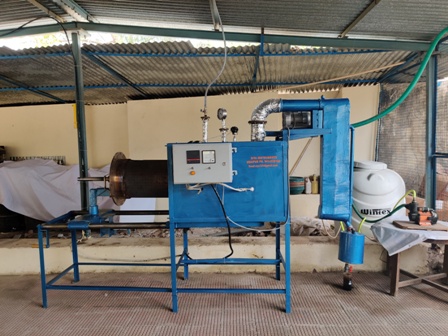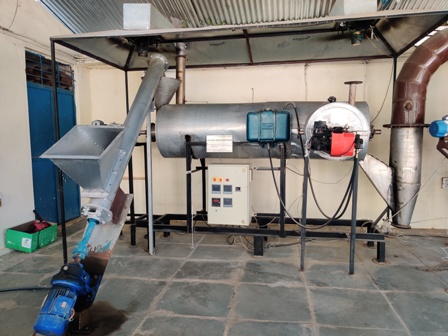This is excellent news for protected cultivation farmers who are continuously growing cucumbers, as the quality of their soil is degrading day by day. Recently, scientists from Shandong Agricultural University in China conducted a study where they discovered a sustainable alternative to prevent soil degradation under greenhouse conditions.
Table of Contents
New Research on Biochar
Researchers conducted evaluations on biochar derived from three distinct farm wastes: tomato straw (TSB), sweet pepper straw (SPSB), and eggplant straw (ESB). They assessed the nutrient content, cation exchange capacity, and adsorption rates of these biochar variants for cucumber-grown greenhouse purposes.
The researchers found that biochar made from sweet pepper straw was superior for biochar preparation due to its elevated levels of nitrogen, phosphorus, and potassium, as well as its enhanced adsorption capacity.
The application of sweet pepper straw biochar can significantly enhance cucumber growth. Scientists conducting experiments in controlled greenhouse environments observed remarkable improvements as compared to other biochar variants.
Specifically, they noted a substantial increase in plant height by 13.01%, stem thickness by 20.79%, leaf area by 50.26%, and dry weight by 58.56%. These findings underscore the potential of sweet pepper straw biochar as a powerful tool for optimizing crop yields and bolstering agricultural productivity under greenhouse conditions.
Incorporating biochar into cucumber-grown soil not only boosted bacterial and fungal diversity but also resulted in a reduction of disease-causing microbes such as Ascomycota and Aspergillus. Furthermore, intriguing shifts were noted in the abundance of Penicillium. The Hengyu Li led research was published in Annals of Microbiology journal in 2024.
Take-home message from new research
The study reported the promising capabilities of moderate sweet pepper straw biochar when used as a soil amendment. It sheds light on its ability to revitalize a harmonious microbial community within the soil, improve soil quality, and support the ongoing cultivation of cucumbers in greenhouse environments. This research brings to the forefront the transformative role that biochar derived from sweet pepper straw can play in optimizing agricultural practices, ensuring sustainable crop production, and fostering ecological balance within farming systems.
What is Biochar
Biochar is a form of charcoal created through the process of pyrolysis, which involves burning organic biomass without oxygen. This absence of oxygen during the burning of farm waste leads to the transformation of organic materials into a carbon-rich substance. The resulting product is characterized by its high porosity and large surface area, making it highly beneficial for various applications.
When incorporated into soil, biochar has the potential to enhance soil fertility, water retention, and nutrient retention. Additionally, it aids in reducing greenhouse gas emissions by sequestering carbon in the soil for extended periods, thus contributing to the mitigation of climate change.
How to Prepare Biochar
Selecting Biomass:
Choose organic materials such as wood chips, crop residues, or agricultural waste. It’s essential to use materials that are free from contaminants like pesticides or chemicals.
Pyrolysis Process
Pyrolysis is the key step in producing biochar. This involves heating the biomass in a low-oxygen or oxygen-free environment to temperatures typically ranging from 300 to 800°C (572 to 1472°F). This can be done using various methods such as kilns, retorts, or specialized pyrolysis reactors.
Cooling and Collection
Once the biomass is heated, it decomposes into biochar, along with gases and liquids. The biochar should then be allowed to cool down before it’s collected. The cooling process is crucial to prevent spontaneous combustion and to ensure the stability of the biochar.
Characterization and Activation
Depending on the intended use, the biochar may undergo additional processing steps such as characterization to determine its properties (porosity, surface area, pH, etc.) and activation to enhance its adsorption capacity. Activation can be achieved through processes like steam activation or chemical activation.
You May also like our other blog posts: Health benefits and culinary uses of fennel pollen
Application
The prepared biochar can be applied to soil directly as a soil amendment to improve soil properties and fertility. It can also be used in various applications such as water filtration, composting, or as a component in growing media.
Machinery available for biochar preparation
College of Technology and Engineering, MPUAT, Udaipur (Rajasthan), India has developed new and innovative machinery for large scale production of continuous biochar. (Images




Source: College of Technology and Engineering, MPUAT, Udaipur (Rajasthan), India
Biochar preparation detailed video
The negative effect of Biochar
However, studies have also reported the detrimental effects of biochar on the greenhouse cultivation of crops. However, these effects depend on the application concentration, the physical and chemical characteristics of the biochar used, and the properties of the target soils.
More information : Li, H., Lou, J., Chen, X. et al. Effects of sweet pepper straw biochar on soil microbial communities and growth of continuously cropped cucumber. Ann Microbiol 74, 12 (2024). https://doi.org/10.1186/s13213-024-01755-w
